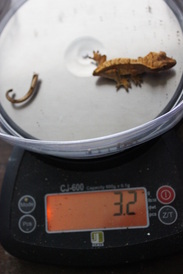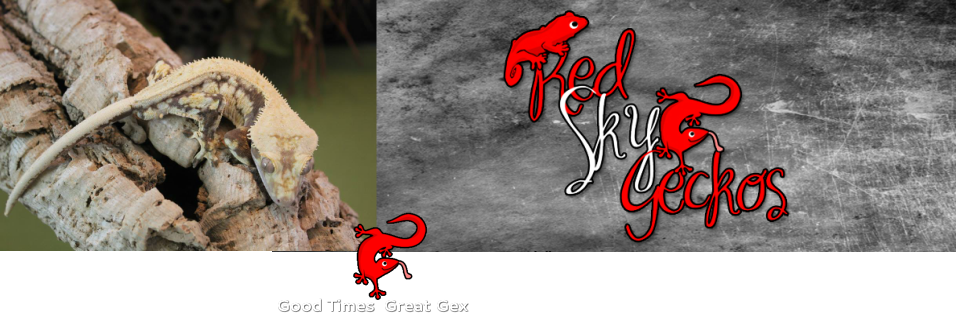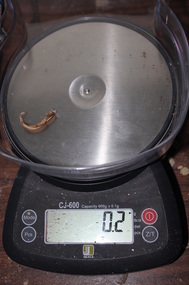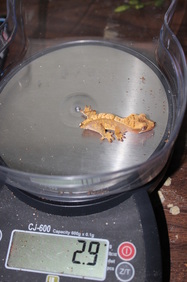Tail Loss

One of the most common questions we hear is "What happens when a gecko loses it's tail?". The answer depends on what type of gecko, but in the case of Crested Geckos they are able to 'throw' their tails at predators and run in another direction while the tail twitches for up to 5 minutes to occupy whatever was chasing them. They do not re-grow their tails.* This is perfectly natural for Crested Geckos and most adults do not have tails in the wild. You will notice that the tail-less gecko is much faster than it used to be without the tail to hold it back. You might also notice that you are more willing to handle it since you don't have to worry about that tail falling off anymore. It can work out well for both of you.
How much does a tail weigh? Roughly 1/10-1/6 of the body weight of the gecko.
Does it hurt them to lose a tail? Hard to imagine that this would be completely pain-free, but if they are throwing the tail (it is not being pulled or cut off) then they are designed to do this. Nature has cleverly designed a break area where the muscles from the tail are joined in a star shape to the body. The gecko can flex these muscles to eject the tail and will use a back foot to help take off the tail as well.
Prevention:
1. Don't grab the gecko by the tail or by the area where it joins the back of the body. Always try to have a hand in front of them rather than grabbing from the rear. Grabbing the rear of their bodies startles them and engages their prey reflex, making them more likely to jump away and/or throw a tail.
2. Keep cats/dogs and other geckos away from your Crested Gecko. The stress of being around a predator can be enough for a tail drop.
3. Try to keep your Crested Gecko in a low traffic/low noise area. Sitting by a loud computer/game system/T.V. etc is not the best place for them.
4. House them alone, resist the temptation to co-habitate. Companions seem like a good idea to us, since we humans are very social creatures. To a Crested Gecko however, a companion is competition for food and territory and a constant source of stress. Tails very often pay the price in an argument and sometimes the tail can be eaten as a snack by a protein hungry cage mate. If the geckos are too mismatched in size the entire gecko can get eaten. Crested Geckos can be opportunistic feeders as can many other species of gecko.
Medical Treatment:
You don't actually have to do anything If your Crestie loses it's tail. The area should seal by itself and heal. But if you are concerned then you can apply Reptaide or an antibiotic like Triple antibiotic to the stump-just make sure it does not contain a pain killer/analgesic as this can be toxic. Keep his cage nice and clean and not too damp with a paper towel substrate so that the area won't get infected. Check regularly for about 2 weeks to make sure that no infection is present. It is natural for the area to turn darker and a healing area on a gecko can be a grayish color. If the wound is seeping or black and spreading or if the gecko seems to have lost energy and weight, then treatment might be required. If you feed bugs you might hand feed a couple dusted crickets (don't leave in the cage) or leave a little dish of Dubia for some extra protein to assist his body in healing. If he was very stressed during the incident he just might want to hide for the day-don't worry if this is the case. If it is cool inside, you might want to give him the option of a lamp to bask in while he is healing. Warmth often helps them to heal quicker. Make sure he is able to get out of the warmth and retreat to a cool side of the cage so that he can thermo-regulate.
*Mainland or GT Chahoua, Gargoyle geckos, Leachianus geckos, and Phelsuma Grandis are able to re-grow tails if they are removed or lost from the base. The tail might not re-grow if the injury was further down the tail. PI Chahoua sometimes regrow part of the tail if lost from the base.
How much does a tail weigh? Roughly 1/10-1/6 of the body weight of the gecko.
Does it hurt them to lose a tail? Hard to imagine that this would be completely pain-free, but if they are throwing the tail (it is not being pulled or cut off) then they are designed to do this. Nature has cleverly designed a break area where the muscles from the tail are joined in a star shape to the body. The gecko can flex these muscles to eject the tail and will use a back foot to help take off the tail as well.
Prevention:
1. Don't grab the gecko by the tail or by the area where it joins the back of the body. Always try to have a hand in front of them rather than grabbing from the rear. Grabbing the rear of their bodies startles them and engages their prey reflex, making them more likely to jump away and/or throw a tail.
2. Keep cats/dogs and other geckos away from your Crested Gecko. The stress of being around a predator can be enough for a tail drop.
3. Try to keep your Crested Gecko in a low traffic/low noise area. Sitting by a loud computer/game system/T.V. etc is not the best place for them.
4. House them alone, resist the temptation to co-habitate. Companions seem like a good idea to us, since we humans are very social creatures. To a Crested Gecko however, a companion is competition for food and territory and a constant source of stress. Tails very often pay the price in an argument and sometimes the tail can be eaten as a snack by a protein hungry cage mate. If the geckos are too mismatched in size the entire gecko can get eaten. Crested Geckos can be opportunistic feeders as can many other species of gecko.
Medical Treatment:
You don't actually have to do anything If your Crestie loses it's tail. The area should seal by itself and heal. But if you are concerned then you can apply Reptaide or an antibiotic like Triple antibiotic to the stump-just make sure it does not contain a pain killer/analgesic as this can be toxic. Keep his cage nice and clean and not too damp with a paper towel substrate so that the area won't get infected. Check regularly for about 2 weeks to make sure that no infection is present. It is natural for the area to turn darker and a healing area on a gecko can be a grayish color. If the wound is seeping or black and spreading or if the gecko seems to have lost energy and weight, then treatment might be required. If you feed bugs you might hand feed a couple dusted crickets (don't leave in the cage) or leave a little dish of Dubia for some extra protein to assist his body in healing. If he was very stressed during the incident he just might want to hide for the day-don't worry if this is the case. If it is cool inside, you might want to give him the option of a lamp to bask in while he is healing. Warmth often helps them to heal quicker. Make sure he is able to get out of the warmth and retreat to a cool side of the cage so that he can thermo-regulate.
*Mainland or GT Chahoua, Gargoyle geckos, Leachianus geckos, and Phelsuma Grandis are able to re-grow tails if they are removed or lost from the base. The tail might not re-grow if the injury was further down the tail. PI Chahoua sometimes regrow part of the tail if lost from the base.


